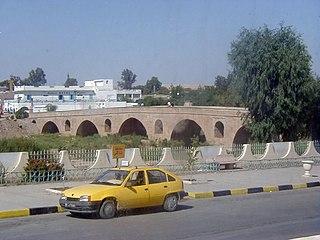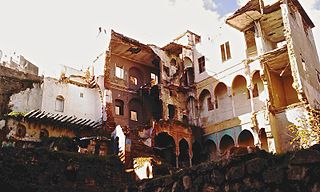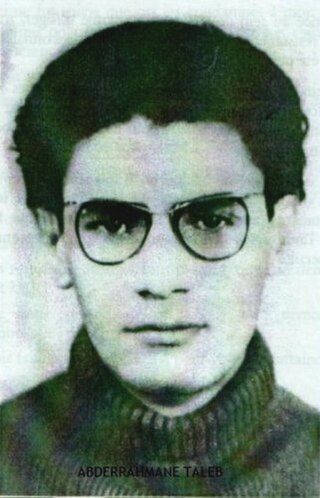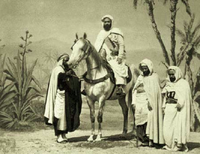
Algiers is the capital and largest city of Algeria as well as the capital of the Algiers Province. The city's population at the 2008 census was 2,988,145 and in 2020 was estimated to be around 4,500,000. Located in the north-central part of the country, it extends along the shores of the Bay of Algiers in the heart of the Maghreb region making it classified among the biggest cities in North Africa, the Arab world and the Mediterranean, due to it being a major center of culture, arts, gastronomy and trade.

Tiaret is a province (wilaya) of Algeria. The capital is Tiaret.

Tissemsilt is the 38th province of Algeria with the capital being Tissemsilt. Théniet El Haâd National Park is located there.

The Battle of Isly was fought on August 14, 1844, between France and Morocco, near the Isly River. French forces under Marshal Thomas Robert Bugeaud routed a much larger, but poorly organized, Moroccan force, mainly fighters from the tribes of Beni Snassen, but also from the Beni Angad and Beni Oukil; under Muhammad, son of the Sultan of Morocco, Abd al-Rahman. Bugeaud, attempting to complete the French conquest of Algeria, instigated the battle without a declaration of war in order to force negotiations concerning Moroccan support for the Algerian resistance leader Abd el-Kader to conclude on terms favorable to the French who demanded the Sultan of Morocco to withdraw support for Abd el-Kader.

Majaz al Bab, also known as Medjez el Bab, or as Membressa under the Roman Empire, is a town in northern Tunisia. It is located at the intersection of roads GP5 and GP6, in the Plaine de la Medjerda.

Algiers Province is a province (wilayah) in Algeria, named after its capital, Algiers, which is also the national capital. It is adopted from the old French department of Algiers and has a population of about 8 million. It is the most densely populated province of Algeria, and also the smallest by area.

Elements from the French Armed Forces used deliberate torture during the Algerian War (1954–1962), creating an ongoing public controversy. Pierre Vidal-Naquet, a renowned French historian, estimated that there were "hundreds of thousands of instances of torture" by the French military in Algeria.

The Battle of Algiers was a campaign fought during the Algerian War. It consisted of urban guerrilla warfare and terrorist attacks carried out by the National Liberation Front (FLN) against the French authorities in Algiers, and by the French authorities, army, and French terrorist organizations against the FLN. Both sides targeted civilians throughout the battle. The conflict began with attacks by the FLN against the French forces and Pieds-Noirs followed by a terrorist attack on Algerian civilians in Algiers by a group of settlers, part of the terrorist group "La Main Rouge", aided by the police. Reprisals followed and the violence escalated, leading the French Governor-General to deploy the French Army in Algiers to suppress the FLN. Civilian authorities gave full powers to General Jacques Massu who, operating outside legal frameworks between January and September 1957, eliminated the FLN from Algiers. The use of torture, forced disappearances and illegal executions by the French later caused controversy in France.
Bab Ezzouar is a suburb of the city of Algiers in northern Algeria. It is one of Algiers fastest growing municipalities and has seen many hotels and commercial malls being raised in the area. Bab Ezzouar is also the location of the University of Science and Technology of Houari Boumediene (USTHB), which is one of the most prominent technological universities in Algeria.

The Battle of Bab el Oued was a violent confrontation which occurred during the latter stages of the Algerian War (1954–1962) between the French Army and the Organisation armée secrète (OAS) which opposed Algerian independence. It took place in Bab El Oued, then a working-class European quarter of Algiers, from 23 March to 6 April 1962.
The First Battle of El Djorf took place on 22 September 1955, during the Algerian War, between the National Liberation Army and the French Army.

The Emirate of Mascara, Emirate of Abd al-Qadir, was a sovereign country founded by Abd al-Qadir al-Jazairi with the allegiance of the people of Algeria to resist the French conquest of Algeria with its first capital at Mascara then Tagdemt after it was taken by France.
The Battle of Bouzegza took place during the Algerian War in the Berber-speaking region of the Adrar Azegzaw massif, at the far eastern end of the Mitidja Plain.

Bordj Tamentfoust is a fort in the city of Tamentfoust, Algeria. The fort, built on the highest point of Tamentfoust, at the eastern end of the Bay of Algiers, is among several forts built to guard the city during the Regency period. With the exception of Bordj Tamentfoust, most of the forts no longer exist or in a good condition.

Bab el-Mrissa, also known as Bab al-Mellah, is a gate in the city of Salé, Morocco. The gate was commissioned by the Marinid sultan Abu Yusuf Yaqub ibn Abd Al-Haqq between 1270—1280. It is one of the largest as well as the oldest gates in Morocco, and the main landmarks of the city.
Sara Lalama, is an Algerian actress. She had roles in the television serials Masha'er, Le rendez-vous and Hob Fi Kafas El Itiham.

Abderrahmane Taleb, also known by his wartime pseudonym Mohand Akli, born on 5 March 1930 in the Casbah of Algiers, was the artificer of the Autonomous Zone of Algiers during the Battle of Algiers. He was guillotined on 24 April 1958 at the Barberousse Prison in Algiers.
The Battle of Fellaoucene took place near Tlemcen on 20 April 1957 during the Algerian War of Independence.
The Battle of Ath Yahia Moussa was an armed conflict during the Algerian War that took place on January 6, 1959, in the Kabylia region of Algeria. This battle involved the National Liberation Army (ALN) against the French Army.

The Battle of Essien, also known as the Battle of Isin, took place in October 1957, in the village of Essien, located south of the Libyan town of Ghat. This significant engagement emerged from the complex dynamics of the Algerian War of Independence against French colonial rule.














